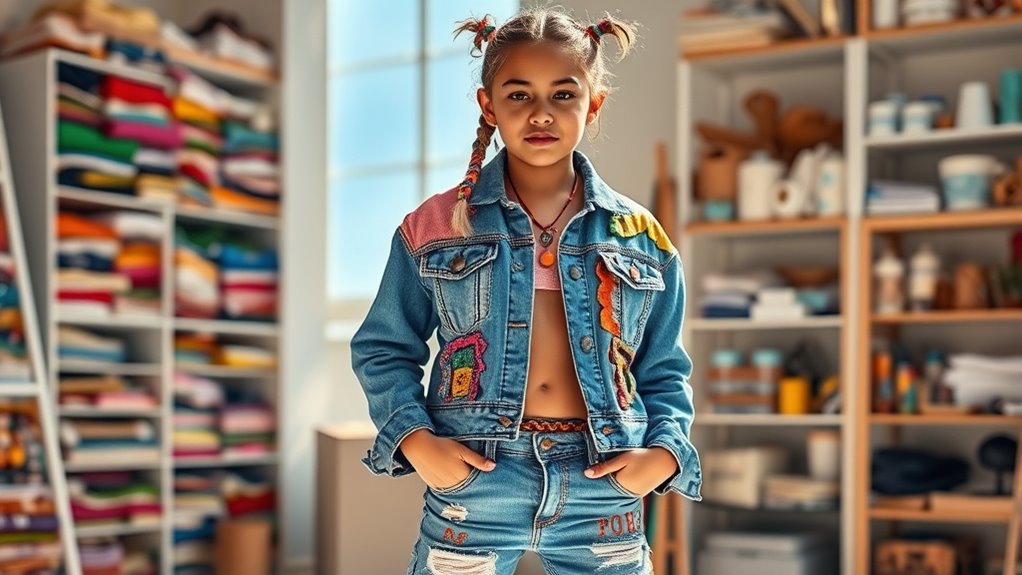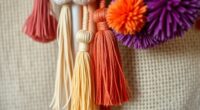In 2025, DIY fashion is all about upcycling old clothes into trendy, eco-friendly pieces, adding personal touches like embroidery or patches, and creating unique accessories such as jewelry and bags from recycled materials. Techniques like fabric painting, sewing hacks, and vintage repurposing help you craft stylish, sustainable outfits. Sharing your creations on social media can inspire others to join the movement. Keep exploring to discover more innovative hacks transforming personal style this year.
Key Takeaways
- Upcycling vintage clothing into unique, eco-friendly fashion pieces is a major trend in 2025 DIY style.
- Personalized embroidery, patches, and custom designs allow individuals to craft statement wardrobe items.
- Creative use of recycled materials like fabric scraps and jewelry components enhances sustainable accessories.
- Innovative fabric painting and embroidery techniques add personalized textures and vivid designs to homemade garments.
- DIY fashion kits and trend-inspired tools empower enthusiasts to create stylish, on-trend pieces at home.
The Rise of Upcycling: Turning Old Clothes Into Trendy Pieces
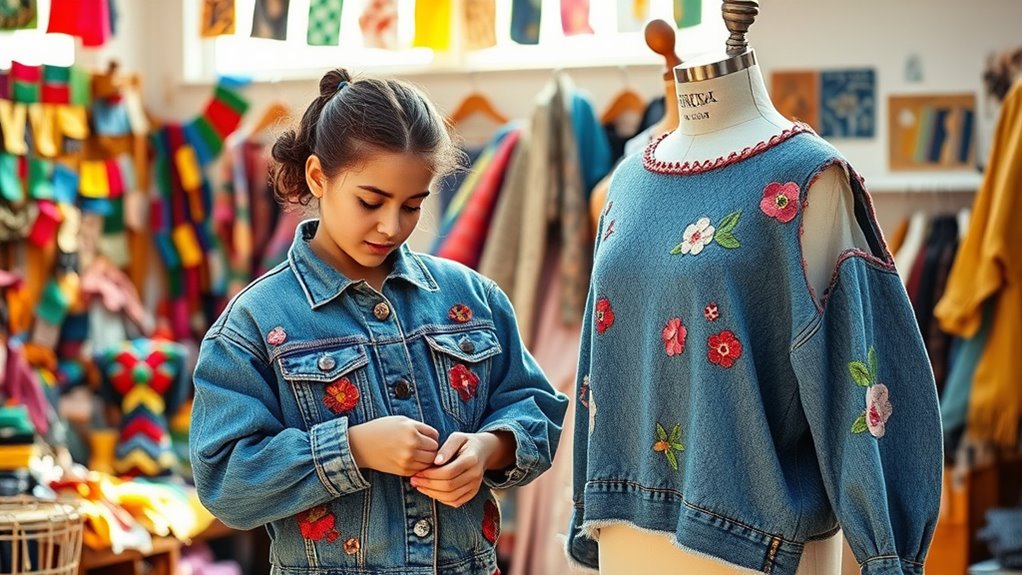
While fast fashion encourages disposable clothing, upcycling offers a sustainable alternative that transforms old garments into stylish new pieces. You can breathe new life into worn-out items by incorporating vintage patterns, giving your wardrobe a timeless touch. Upcycling also reduces waste, making it eco-friendly, and many creators focus on using sustainable packaging to minimize environmental impact. By repurposing fabric scraps or old clothing, you turn what could be trash into statement pieces. This process allows you to showcase your creativity while caring for the planet. Innovation and Discovery in sustainable materials is driving new methods to make upcycling even more effective and eco-conscious. Whether you’re adding patches, embroidery, or new elements, upcycling results in one-of-a-kind fashion that’s both stylish and sustainable. It’s a smart way to stay trendy without contributing to fast fashion’s environmental toll. Incorporating sustainable materials into your DIY projects further enhances the eco-friendly aspect of your fashion hacks, especially as advancements in beach body techniques continue to evolve.
Customizing Basics: Personal Touches That Elevate Everyday Wear
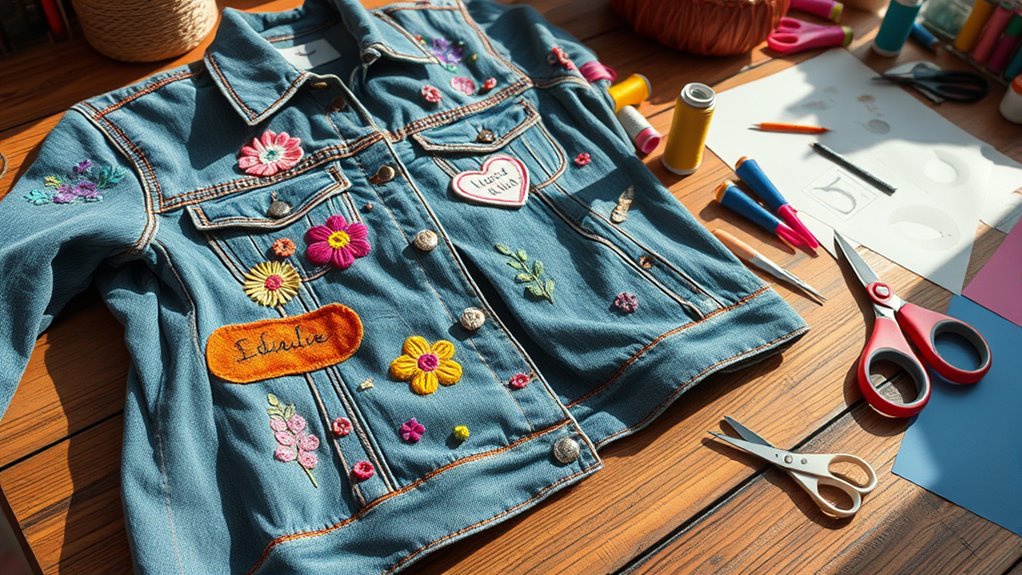
Adding personal touches to your everyday wardrobe is an easy way to stand out and make your outfits uniquely yours. Custom embroidery is a popular method, allowing you to add intricate designs or initials to plain shirts and jackets, instantly elevating their look. Personalized patches are another versatile option; you can sew or iron them onto jeans, backpacks, or hoodies to showcase your personality or interests. These simple modifications transform basic pieces into statement items without much effort or expense. By choosing unique patches or embroidery styles, you create a wardrobe that reflects your style and individuality. Incorporating emotional alignment techniques can help you develop a unique and cohesive wardrobe that aligns with your personal identity and fashion preferences. Whether you’re customizing a favorite denim jacket or a simple t-shirt, these personal touches make your everyday wear more meaningful and stylish, all while keeping it easy and fun.
DIY Accessories: Crafting Unique Jewelry and Bags at Home
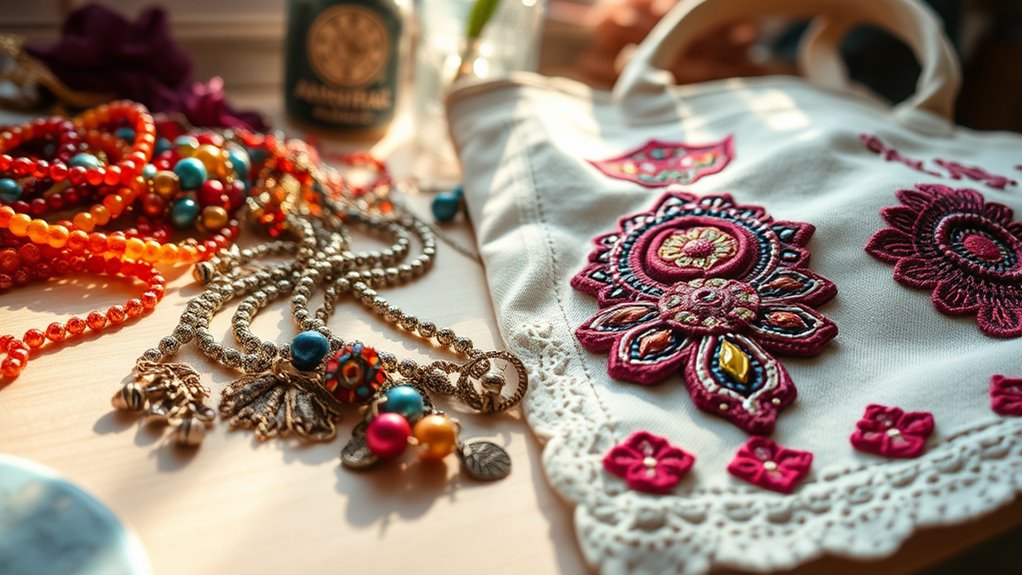
Creating your own jewelry from recycled materials not only saves money but also makes your accessories eco-friendly and unique. Handmade bags allow you to express your style with custom designs and personal touches. Both options give you the chance to craft standout pieces that truly reflect your personality. To ensure your creations are durable and stylish, consider using regulatory compliance guidelines when sourcing and assembling your materials. Incorporating DIY techniques can also enhance the quality and creativity of your projects. Exploring popular anime movies can inspire creative designs and themes for your accessories, adding a touch of cultural flair to your handmade items.
Recycled Material Jewelry
Have you ever considered transforming everyday scrap materials into stunning jewelry? Recycled material jewelry lets you create bold statement accessories that stand out and reflect your eco-conscious style. Use old bottle caps, broken jewelry, or leftover fabric to craft unique pieces that turn trash into treasure. Incorporate vintage jewelry components to add a nostalgic touch or mix different textures for an eclectic look. This DIY approach not only reduces waste but also allows you to personalize your accessories with meaningful, one-of-a-kind designs. Whether you’re making layered necklaces, earrings, or brooches, recycled materials give you endless possibilities. Plus, crafting your own jewelry makes each piece special, letting you showcase your creativity while making a positive impact on the environment.
Handmade Bag Designs
If you’re looking to personalize your accessories, handmade bag designs offer a fantastic way to express your style and creativity. By exploring artisanal craftsmanship, you can create unique bags that reflect your personality. Start with simple techniques like sewing, embellishing, or weaving to craft one-of-a-kind pieces. Whether you use recycled fabrics or sustainable materials, your handmade bag will stand out. Here are some ideas to inspire you:
- Customize with embroidery or fabric paint for a personalized touch
- Incorporate natural materials like jute or cork for eco-friendly designs
- Use upcycled or thrifted fabrics to add a vintage vibe
Embracing sustainable materials can also enhance the appeal and environmental friendliness of your designs. Handmade bag designs allow you to showcase your skills and create functional art, making your accessories truly original. Recognizing the value of yoga’s holistic healing can inspire you to invest time and effort into developing your craft into a valuable asset.
Fabric Painting and Embroidery: Adding Artistic Flair to Your Wardrobe
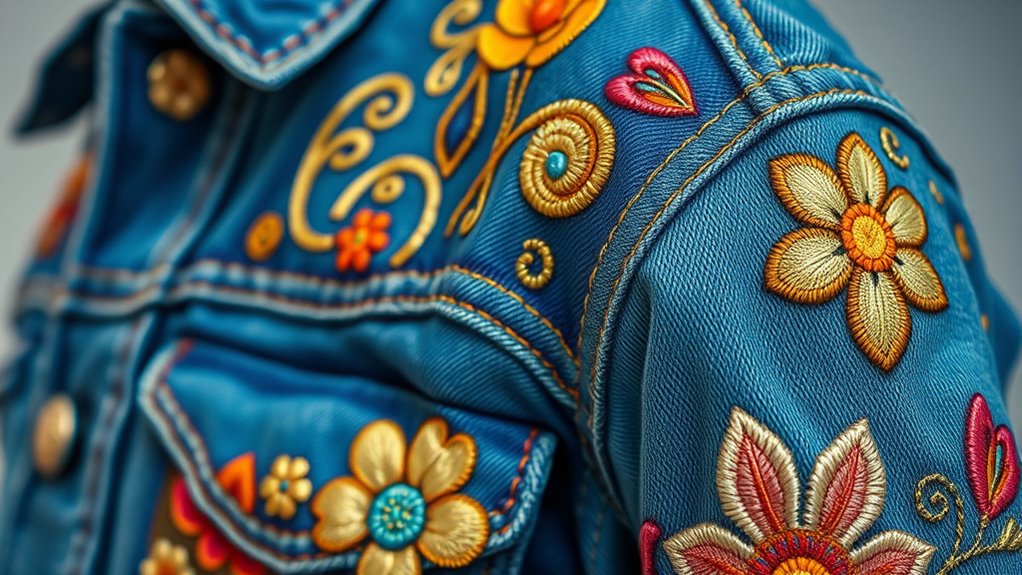
Fabric painting and embroidery offer exciting ways to infuse your wardrobe with personal artistry. With fabric art, you can create vivid designs directly on clothing, turning simple pieces into statement items. Use fabric paints to add bold colors, patterns, or even intricate scenes, customizing each item to your style. Embroidery enhances garments through detailed threadwork techniques, giving texture and depth. You might try hand-stitched floral motifs or geometric accents, elevating plain fabrics with craftsmanship. Both methods allow you to experiment with colors, motifs, and textures, making each piece uniquely yours. Whether you prefer quick fabric painting or delicate embroidery, these DIY techniques help you craft personalized fashion that reflects your creativity and taste. Incorporating proper materials and techniques ensures your designs are durable and professional-looking. Additionally, exploring color theory can help you select harmonious color combinations that make your designs stand out. Embracing the rise of AI in education can also inspire innovative ways to learn new textile techniques through digital tutorials and virtual workshops.
Repurposing Vintage Finds: Giving New Life to Secondhand Items
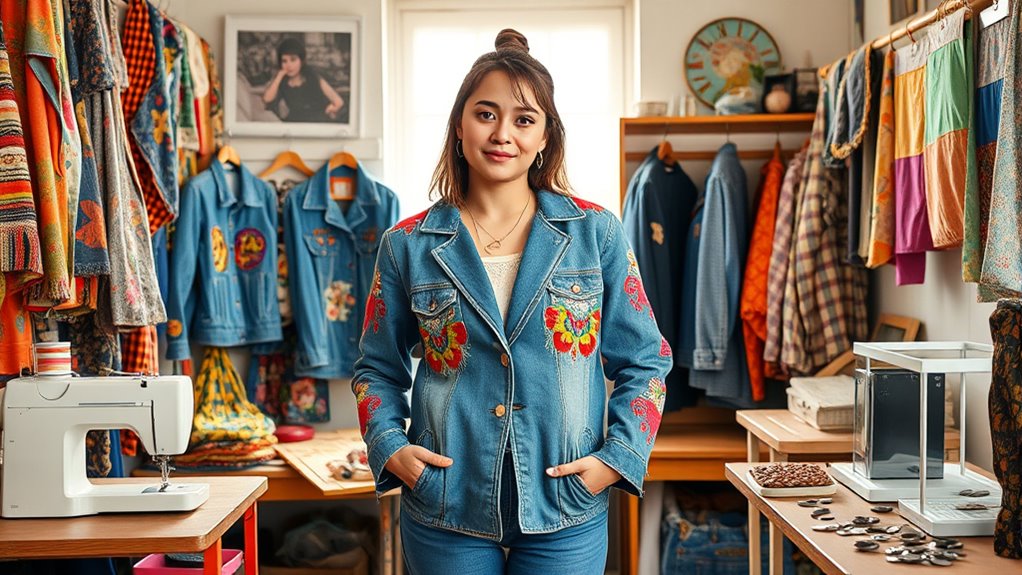
You can transform vintage finds into unique pieces using creative upcycling techniques that showcase your personal style. By repurposing secondhand items, you make sustainable choices that benefit both your wardrobe and the environment. This approach allows you to craft one-of-a-kind fashion statements while reducing waste. Incorporating sustainable practices in your fashion projects aligns with the growing consumer demand for environmentally friendly products. Additionally, understanding clutter management can help you stay organized and prevent future accumulation of unnecessary items, making your decluttering efforts more effective and sustainable. Furthermore, understanding cryptocurrency regulations can help you make informed decisions when exploring new investment opportunities.
Creative Upcycling Techniques
Revamping vintage finds offers a creative way to breathe new life into secondhand items, transforming them into unique fashion pieces. With creative upcycling techniques, you can turn old jeans into trendy shorts, repaint worn-out jackets, or add embellishments to plain shirts. These methods aren’t just fun—they’re perfect for gaining style inspiration and sharing your DIY projects through fashion blogging. To get started, consider:
- Dyeing fabrics to create custom colors
- Adding patches or embroidery for a personalized touch
- Cutting and reshaping garments for modern silhouettes
Sustainable Wardrobe Choices
Choosing vintage finds for your wardrobe is a smart way to embrace sustainability while expressing your unique style. Thrift shopping allows you to discover one-of-a-kind pieces that breathe new life into your closet. By repurposing these secondhand items, you contribute to reducing waste and support eco-friendly fashion practices. Building a capsule wardrobe with vintage staples simplifies your dressing routine and minimizes environmental impact. Incorporating energy-efficient pieces further enhances your wardrobe’s sustainability and reduces your overall carbon footprint. Additionally, selecting pieces made from sustainable fabrics can further lower your fashion-related environmental impact. Here’s a quick guide:
| Tip | Benefit |
|---|---|
| Shop seasonally | Finds are more stylish and versatile |
| Focus on quality | Pieces last longer, reducing waste |
| Customize thrift | Make items uniquely yours with DIY hacks |
| Mix vintage with modern | Creates fresh, sustainable looks |
| Prioritize essentials | Easy to assemble a capsule wardrobe |
This approach keeps your style sustainable, affordable, and personalized.
Tie-Dye and Color Techniques: Creating Vibrant, One-of-a-Kind Looks
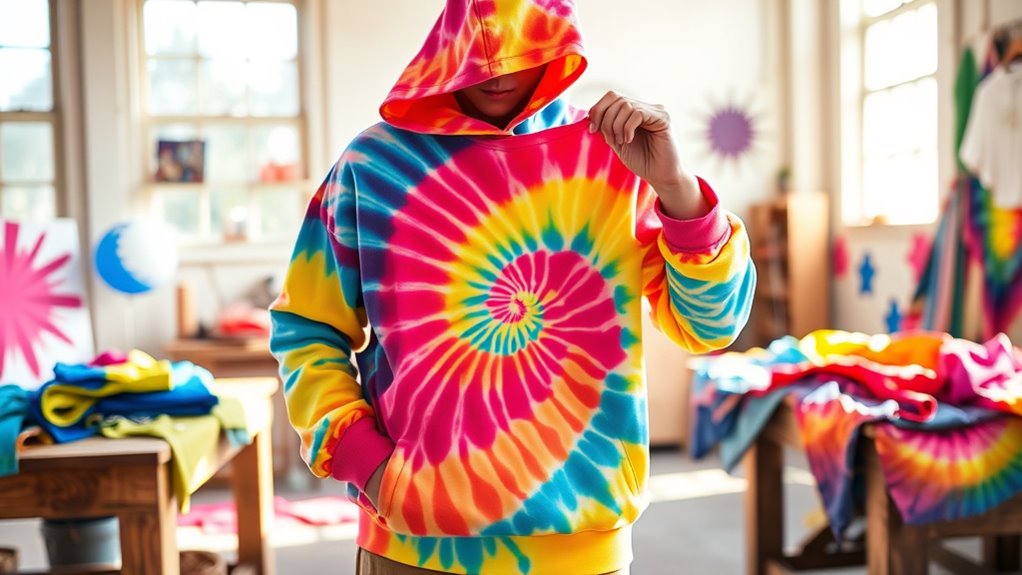
Tie-dye and other color techniques offer a fun and expressive way to transform plain fabrics into vibrant, one-of-a-kind pieces. By experimenting with fabric blending, you can create seamless progressions between colors, giving your designs a professional look. Color gradient techniques allow you to gradually shift hues, producing eye-catching effects that stand out. To get started, consider these tips:
Explore vibrant fabric blending and gradient techniques to create unique, eye-catching tie-dye designs.
- Use different dye concentrations to achieve unique fabric blending effects.
- Fold and tie fabrics in various ways to create diverse patterns and color distributions.
- Practice applying color gradients with sponges or brushes for more control over the look.
- Incorporating essential oils for fabric preservation into your creative process can help you better understand and troubleshoot color blending techniques, ensuring your designs are both vibrant and secure from accidental mishaps.
These methods help you craft vibrant, personalized clothing that reflects your style while making each piece truly one-of-a-kind.
Sewing Hacks for Perfect Fit and Style Adjustments
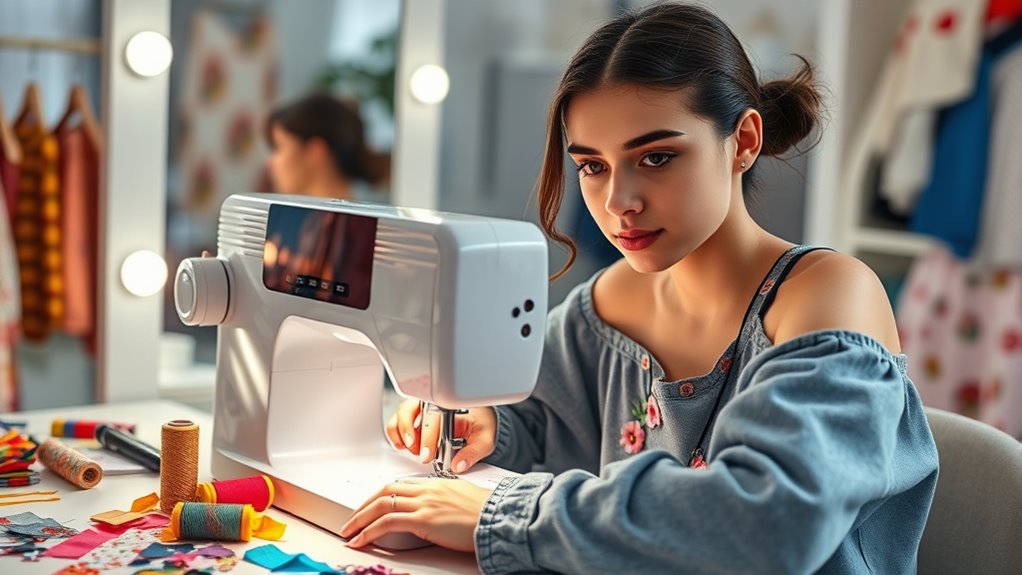
Getting the perfect fit and style in your handmade garments often comes down to smart sewing hacks that save time and improve results. Mastering alteration techniques lets you tailor clothes precisely to your body, ensuring comfort and a polished look. Use fitting tips like pinning fabric before sewing to avoid guesswork, and always measure carefully for adjustments. Shortening or lengthening hems with simple techniques can instantly elevate your style, while taking in seams can refine the silhouette. Don’t forget to test alterations on scrap fabric first to prevent mistakes. With these sewing hacks, you’ll achieve professional-looking results effortlessly. Whether adjusting waistbands, sleeves, or side seams, applying these tips makes every project fit better and look more stylish, giving your DIY wardrobe a custom, flawless finish. Additionally, understanding fabric behavior helps you select the right sewing techniques for different materials, ensuring your alterations hold up over time.
Sustainable Fashion: Embracing Eco-Friendly DIY Practices

You can make a positive impact by upcycling old garments into fresh, stylish pieces, reducing waste and giving clothes new life. Natural dye techniques let you create vibrant colors without harmful chemicals, making your DIY projects eco-friendly. Embracing these practices helps you craft unique fashion while caring for the planet.
Upcycling Old Garments
Upcycling old garments offers a creative and eco-friendly way to refresh your wardrobe while reducing waste. By transforming existing pieces, you support fashion sustainability and minimize the need for new resources. Use eco conscious materials like repurposed fabrics or natural trims to enhance your projects. To get started, consider these ideas:
- Turn worn-out T-shirts into stylish tote bags or crop tops
- Add embellishments or patches to old jeans for a trendy update
- Convert oversized shirts into unique dresses or skirts
Upcycling not only saves money but also encourages you to think creatively about your clothing. It reduces textile waste and promotes sustainable fashion habits. Embracing these DIY hacks helps you contribute to a healthier planet while expressing your personal style.
Natural Dye Techniques
Have you ever considered using natural dyes to give your clothing a vibrant, eco-friendly touch? Plant-based dyes are a fantastic way to achieve rich colors while reducing environmental impact. You can source natural pigments from things like berries, turmeric, onion skins, or indigo leaves through natural pigment sourcing. These dyes are safe, sustainable, and perfect for DIY projects. To get started, simmer your chosen plant materials to extract the pigment, then soak your fabric in the dye bath. The results are unique and beautifully earthy shades that can’t be matched with synthetic dyes. Experimenting with natural dye techniques not only enhances your wardrobe but also supports eco-conscious fashion. Plus, it’s a simple, rewarding way to embrace sustainable practices in your DIY style hacks.
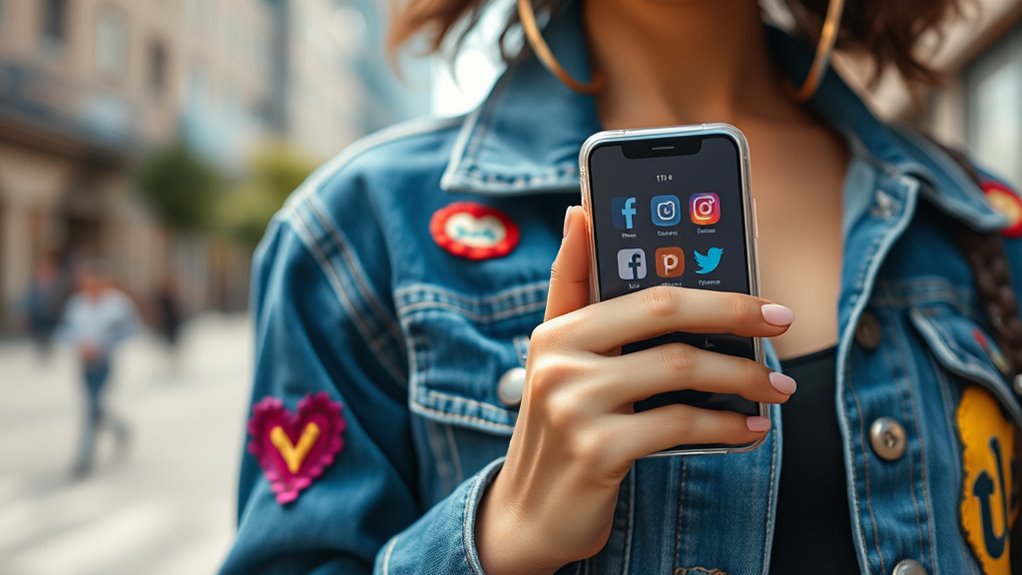
Ever wondered how social media has transformed DIY fashion into a global movement? It’s now easier than ever to share your creations and inspire others. When you post your homemade styles, you can spark viral shares that reach thousands, boosting your influence. Influencer collaborations also help showcase your hacks to wider audiences, encouraging more people to try their hand at DIY fashion. Social media platforms like Instagram and TikTok make it simple to connect with a community of passionate creators. By sharing your unique ideas, you not only gain recognition but also motivate others to experiment. Remember, your posts can ignite trends, foster creativity, and build a supportive network of fashion enthusiasts enthusiastic to learn from your experience.
Tools and Materials Every DIY Fashion Enthusiast Needs
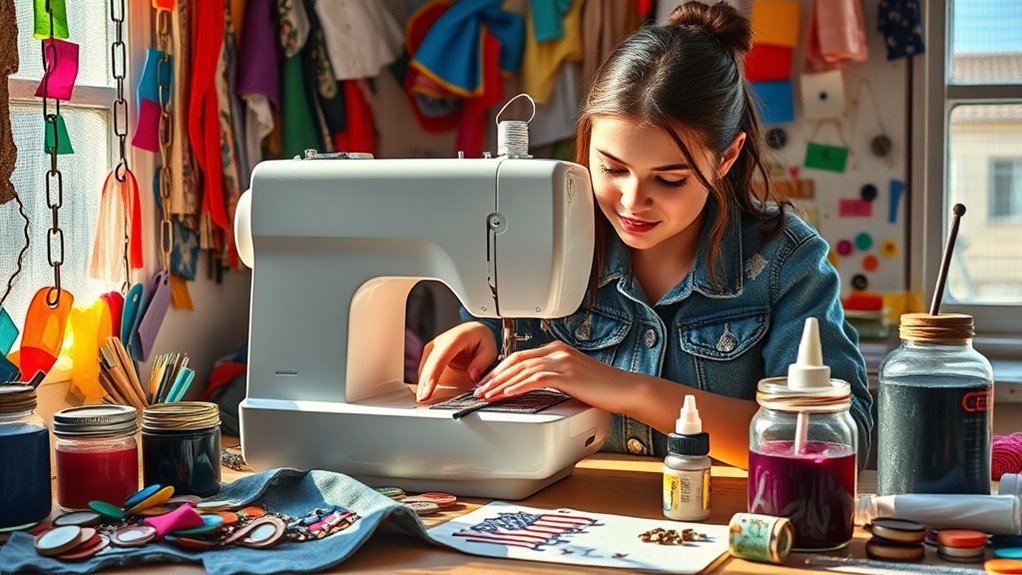
To start creating your own fashionable pieces, you’ll need a basic toolkit of essential tools and materials. First, invest in quality fabric scissors for clean cuts, and a sewing kit with needles, threads, and pins for quick fixes. Keep fabric care supplies like stain removers and fabric sprays to maintain your creations’ look and longevity. A hot glue gun and fabric glue are handy for quick embellishments or repairs. Staying ahead of trend forecasting helps you choose on-trend fabrics, colors, and patterns, so your designs stay fresh. Consider a rotary cutter for precise cuts on larger projects and a measuring tape for accurate sizing. With these tools and a keen eye on trend insights, you’ll be well-equipped to craft unique, stylish pieces that turn heads in 2025’s DIY fashion scene.
Frequently Asked Questions
How Can Beginners Start With DIY Fashion Projects Easily?
If you’re new to DIY fashion projects, start with simple ideas like beginner sewing tips and easy upcycling ideas. Choose old clothes or accessories and transform them into fresh, stylish pieces. Use basic stitches and avoid complicated patterns initially. Watch tutorials online, gather simple tools, and be patient. With small, manageable projects, you’ll build confidence and gradually explore more creative DIY fashion hacks.
What Are the Safest and Most Eco-Friendly Materials for DIY Fashion?
You should prioritize sustainable fabrics like organic cotton, hemp, and bamboo, which are eco-friendly and safe for your skin. Use eco-friendly dyes such as plant-based or natural dyes that minimize chemical use and reduce environmental impact. These materials are easy to work with for beginners and help you create stylish, planet-friendly pieces. By choosing these options, you guarantee your DIY fashion projects are both safe and environmentally conscious.
How Do I Ensure My Homemade Fashion Items Are Durable?
Your homemade fashion items can be nearly indestructible if you master the art of fabric care and stitching techniques. Use sturdy, high-quality materials, and always follow proper washing instructions. Reinforce seams with strong stitches, like double stitching or zigzag, to prevent tearing. Regularly check and mend any weak spots. With attention to detail and proper care, your DIY creations will stand the test of time, outlasting even the most commercial garments.
Can DIY Fashion Be Cost-Effective Compared to Buying Retail?
You can definitely make DIY fashion cost-effective compared to buying retail. By repurposing materials and using inexpensive supplies, you save money and create unique pieces. DIY projects often lead to significant cost savings, making it a budget-friendly fashion choice. Plus, customizing your items guarantees you get exactly what you want without overspending, helping you stay stylish while sticking to your budget. This approach combines creativity with affordability.
How Do I Protect My Designs From Fading or Damage Over Time?
Imagine your vibrant DIY creations as precious paintings that deserve protection. To keep them looking fresh, focus on fabric care by washing gently and avoiding harsh detergents. Apply protective coatings like fabric sealants to shield against fading and damage. Store your designs in a cool, dry place, and avoid prolonged sun exposure. These simple steps help preserve your handmade style, making your creations last and stay stunning over time.
Conclusion
Did you know that over 70% of fashion waste is preventable through simple DIY hacks? By upcycling, customizing, and crafting your own pieces, you not only save money but also help reduce environmental impact. Embrace these trends to express your unique style and inspire others to join the movement. With just a few tools and creative ideas, you can make a difference—one stylish, sustainable piece at a time.
